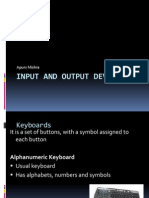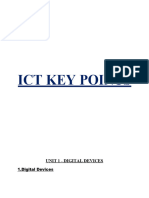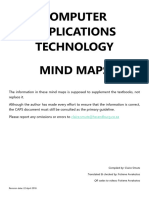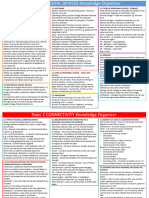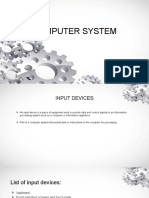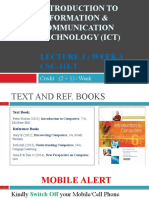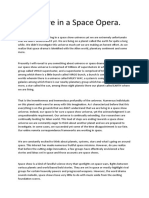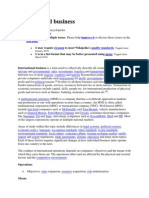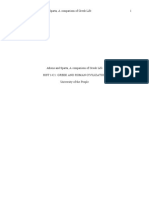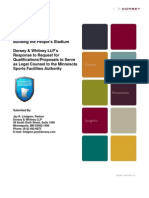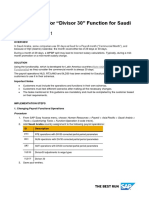ICT NOTES
ICT NOTES
USER INTERFACE
Users command and instruct devices through the user interface
CLI – Command Line Interface
Enter instructions as text
Results as text
Usually used in old systems with little storage
Commands have to be exactly right, for the system to return the
required results (Disadvantage )
Menu Driven Interface
Menus with options will be displayed
Trigger a command or open another menu
Could take time, due to repeated menus
Usually used in ATM’s
GUI- Graphical User Interface
Used based on a system – WIMP
W- Areas of screen dedicated to the application
I- Small images that represent applications
M- A menu of the options to open applications or OS tasks
P- Controls the cursor on the screen
Mostly user friendly
Only need to use WIMP to operate this interface
Voice Interface
Allows the user to give spoken instructions to the system
System matches the spoken words against a library
Sometimes system gives us an incorrect match creating unwanted
results & tension
Advantageous feature is that it allows a hands-free operation
Gesture Interface
Device is controlled by swiping the fingers on the screen
Usually found on touch screen devices
FEATURES OF DIGITAL DEVICES
Portability:-
1
�ICT NOTES
A portable device is easy to carry around
Usually related to size and weight
Portable device – Smartphone – HIGH PRIORITY
TV – LOWER PRIORITY
Performance:-
High performance – FASTER SPEED
The speed at which instructions are carried out by the processor
Faster the processor -> HIGHER THE PERFORMANCE
Instructions are loaded onto the processor from the RAM
Faster RAM-> HIGHER THE PERFORMANCE
If RAM is full, storage is used as overflow- called VIRTUAL MEMORY
Storage :-
Used to store files and programs
Higher the storage -> MORE FILES AND PROGRAMS ARE STORED
Storage speed also affects the performance
User Interface:-
Users command and instruct devices through the User Interface
Connectivity:-
Data can be shared between devices through wired or wireless
connections
You can also use connectivity for software updates or backups
WIRED connection -> usually FASTER & MORE reliable
WIRELESS connectivity -> PORABILITY
Media Data:-
Media data is read or written by digital devices
Most devices contain inbuilt media
But some adapters can be provided to externally connect media to
devices
Energy Consumption :-
Most energy consuming devices need electricity to work
LOWER ENERGY CONSUMTION -> LONGER BATTERY LIFE
Nowdays there is a mass production from device engineers
creating :-
- Eco- friendly devices , which are less energy consuming
Expansions:-
More space allows installing additional components
2
�ICT NOTES
They might either have and expansion slot or Ports (USB)
Security :-
Next chapter(DIGITAL SECURITY )
DIGITAL SECURITY
Software Security :-
Set the OS to open only after password or PIN(Personal Identification
Number) is entered
Locks automatically, if not used for a certain period of time. Needs
PIN or password to login again.
If an incorrect PIN is entered, user must wait for a while, to try
again, this prevents hackers to repeatedly trying new options. (if
tried repeatedly, the data on the device might be erased )
Devices have biometric scanners- like TOUCH ID
Physical Security:-
Security slots are created to attach devices to furniture
3
�ICT NOTES
PERIPHERAL DEVICES :-
- A device that can be connected to a computer
- There are 3 types of peripheral devices:-
1. Input
2. Output
3. Storage
INPUT:-
Input devices send data to the computer
Keyboard:-
Uses keys, to input text or interact with the software
Can be connected to computer using wired or wireless connection
Laptops have inbuilt keyboards
Can be used to access common commands using combination of
keys – SHORTCUTS
- eg. To copy – ctrl+C, To paste – ctrl+V
POINTING DEVICE:-
Mouse:-
Uses an optical sensors to recognise movements
Sensitivity of the mouse depends on the surface the mouse is on
Tracker Ball:-
Rolled to move the pointer
There are no buttons in the tracker ball
Track Pads:-
They are commonly found on laptops
The surface of trackpads on laptops sense the movement, presses
and touches of the finger
Joysticks:-
Usually found on game controllers -> used to move sprites around
Graphics Tablet
A flat pad that is used with a stylus
Usually used by digital artist and designers or online comic/ manga
makers
Main function is to draw and write
SCANNERS:-
4
�ICT NOTES
uses light sensors to record physical documents and save as digital
file in the computer.
OCR – Optical Character Recognition:-
this device can be used to recognise characters and save as a text
file
OMR – Optical Mark Recognition
This device can be used to identify marks in a document
They are commonly used to mark multiple choice questions(MCQ’s)
Barcode scanners:-
These scanners scan a pattern of lines and gaps- BARCODE
BARCODES – can be used on parcel – for tracking
BARCODES – represent letters and numbers
BARCODES – can be separates to linear and matrix codes
Linear codes Matrix codes
QR Codes (Matrix Code)-
Can hold more information than linear codes
Can be scanned from any angle
Webcam:-
Specialised camera
Usually have inbuilt microphones
Used a security camera
Used to stream images or videos
Microphone:-
Used to capture sound
Uses a diaphragm which moves when air hits it, this produces an
analogue signal
Microphone then converts analogue -> digital signal using a sound
card
OUTPUT PERIPHERALS:-
5
�ICT NOTES
Devices that are connected to the computer that output information
provided by the CPU.
Can be presented as electronic display, printed form, video, audio,
or tactile form
Monitors
Provides the output as electronic display
This is the most common form of output
Features:-
SCREEN SIZE –measured diagonally
RESOLUTION – measured in pixels
ENERGY EFFICIENCY – methods to save energy(screen savers, power
stand by )
Printer:-
There are three main types of printers :-
1. DOTMATRIX
2. INKJET
3. LASER
Dot matrix printers:-
They impact printers, by hitting the paper through an ink ribbon
Features:-
o Slowest
o Cheap
o Low cost per copy
o Rare color printing
o Low quality
Uses carbon copy layers – so that many copies can be printed at
same time.
Inkjet printers:-
uses cartridges full of ink
spits ink on the paper to form whatever that has to be printed
Features:-
o Fast
o Medium cost
o High cost per copy
o Color printing
o High quality
6
�ICT NOTES
Laser printers:-
Have rotating cylinders with electric charges,
then when laser discharges the points needed so that the tonner is
attracted to those points and an image is heated onto a paper
Features:-
o Fastest
o Expensive
o Medium cost per copy
o Color printing
o High quality
Usually used in high businesses if a lot of printing needs to be done
3D printer:-
Used to create a model for any digital design
It works by adding layers of heat and material from bottom to top.
This takes a lot of time to create a model
Plotter
Draws a high quality drawing of digital design
Usually made through a CAD – Computer Aided Design software
A pen is moved on a paper to make the design
It is often used by designers, architects and engineers
Projectors:-
Used in home entertainment systems or in schools for teaching
Contains:-
o Light bulbs:- they have different brightness levels, so they are
important for projectors and are very expensive to replace
o Resolution:- have different quality of screens
o Zoom functionality:- Allows the projected screen to be
enlarged or made smaller
o Portability:- not all projectors are portable but newer once are
smaller and lighter so they are easier to carry around.
Speakers:-
used to output sound, usually are found in pairs…
this pairs is usually used in home entertainment system and is used
for stereo or surround sound
Control Devices (Actuators ):-
these are devices that make something happen in the real world
these devices are often though as mechanical
7
�ICT NOTES
eg:- valves, pistons, heaters, coolers and motors













